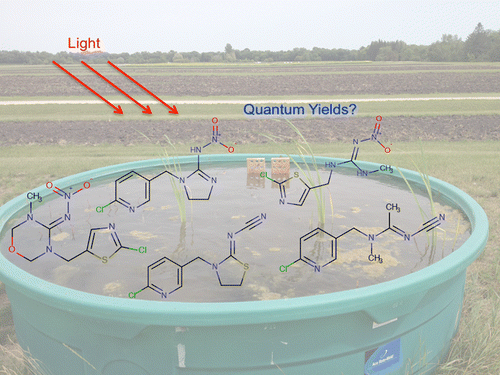Examining the neonicotinoid threat to honey bees

The decline of honey bees has been a major concern globally for the past decade. One of the factors that could be contributing to the decline is the use of insecticides—specifically neonicotinoids—that persist in rivers and streams. Researchers now report in the ACS journal Environmental Science & Technology Letters that although sunlight plays an important role in degrading pollutants, its effects on neonicotinoids can diminish dramatically even in shallow water.
Neonicotinoids protect crops from pests, such as whiteflies, beetles and termites. They are a popular tool in a farmer's arsenal, but they end up washing into surface waters and soil. Some research has suggested the insecticides play a role in the disappearance of bees, a phenomenon known as colony collapse disorder. But scientists didn't fully understand the fate of neonicotinoids in the environment, an important factor in determining how they might contribute to the disorder. Charles S. Wong and colleagues wanted to investigate sunlight's effects on these insecticides in water.
Out of five neonicotinoids the researchers tested in water under simulated sunny conditions, three degraded considerably within minutes.
Two took a few days to break down. But a depth of just 3 inches of water was enough to shield at least one, thiamethoxam, from the degrading effects of the sun. The researchers say that this persistence at shallow depths could increase the chances aquatic life and other wildlife, including bees, could get exposed to the insecticide.
More information: Quantum Yields for Direct Photolysis of Neonicotinoid Insecticides in Water: Implications for Exposure to Nontarget Aquatic Organisms, Environ. Sci. Technol. Lett., Article ASAP. DOI: 10.1021/acs.estlett.5b00136
Abstract
Environmental fate processes of neonicotinoid insecticides are of significant interest, given the serious threats these chemicals can pose to nontarget organisms such as pollinators (e.g., bees). Direct photolysis was investigated using a laboratory photoreactor approximating full-spectrum sunlight to predict the aquatic fate of neonicotinoids. Quantum yields (ϕc) were 0.019 ± 0.001, 0.013 ± 0.001, 0.0092 ± 0.0005, 0.0022 ± 0.0003, and 0.0013 ± 0.0002 for thiamethoxam, clothianidin, imidacloprid, acetamiprid, and thiacloprid, respectively. On the basis of these values, estimated half-lives were 0.2–1.5 days for different seasons in surface waters at temperate latitudes for thiamethoxam, consistent with the 0.98 day half-life observed experimentally outdoors at Winnipeg, Manitoba, Canada (50°N), for thiamethoxam in summer. Light attenuation through shallow clear surface waters (e.g., by natural organic matter) indicated that photolysis of thiamethoxam at depths greater than 8 cm was negligible, which may help explain reports of its environmental persistence.
Journal information: Environmental Science & Technology Letters
Provided by American Chemical Society




















